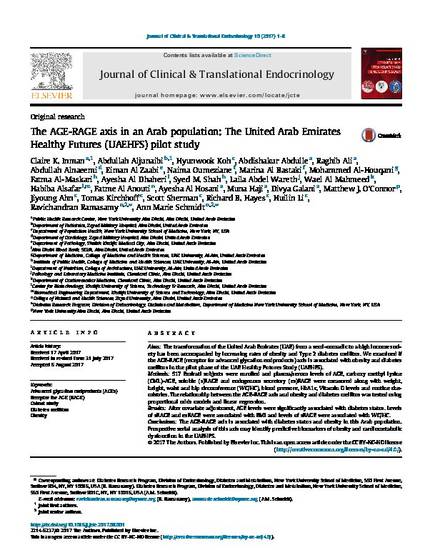
© 2017 The Authors Aims The transformation of the United Arab Emirates (UAE) from a semi-nomadic to a high income society has been accompanied by increasing rates of obesity and Type 2 diabetes mellitus. We examined if the AGE-RAGE (receptor for advanced glycation endproducts) axis is associated with obesity and diabetes mellitus in the pilot phase of the UAE Healthy Futures Study (UAEHFS). Methods 517 Emirati subjects were enrolled and plasma/serum levels of AGE, carboxy methyl lysine (CML)-AGE, soluble (s)RAGE and endogenous secretory (es)RAGE were measured along with weight, height, waist and hip circumference (WC/HC), blood pressure, HbA1c, Vitamin D levels and routine chemistries. The relationship between the AGE-RAGE axis and obesity and diabetes mellitus was tested using proportional odds models and linear regression. Results After covariate adjustment, AGE levels were significantly associated with diabetes status. Levels of sRAGE and esRAGE were associated with BMI and levels of sRAGE were associated with WC/HC. Conclusions The AGE-RAGE axis is associated with diabetes status and obesity in this Arab population. Prospective serial analysis of this axis may identify predictive biomarkers of obesity and cardiometabolic dysfunction in the UAEHFS.
- Advanced glycation endproducts (AGEs),
- Cohort study,
- Diabetes mellitus,
- Obesity,
- Receptor for AGE (RAGE)
Available at: http://works.bepress.com/fatme-alanouti/2/
